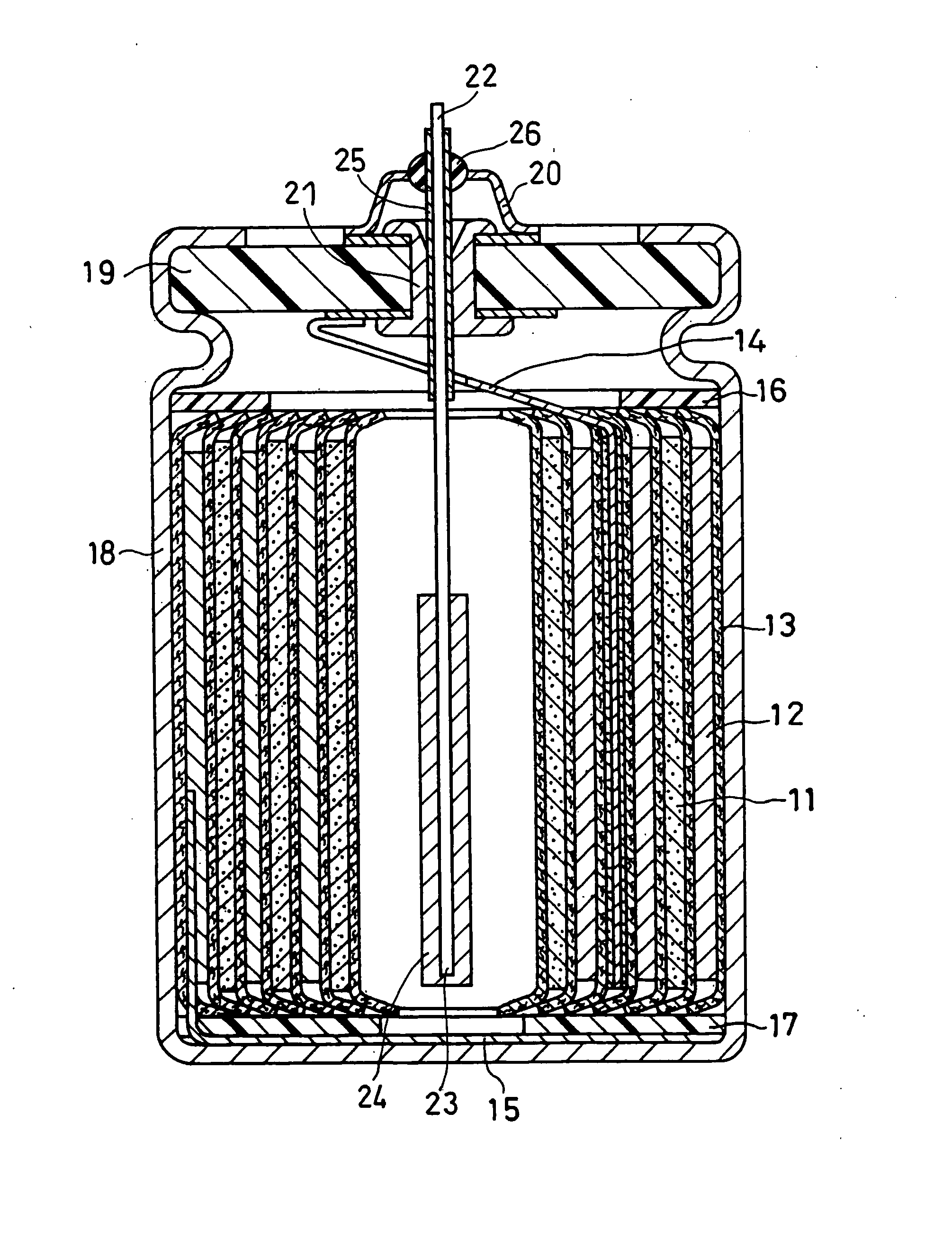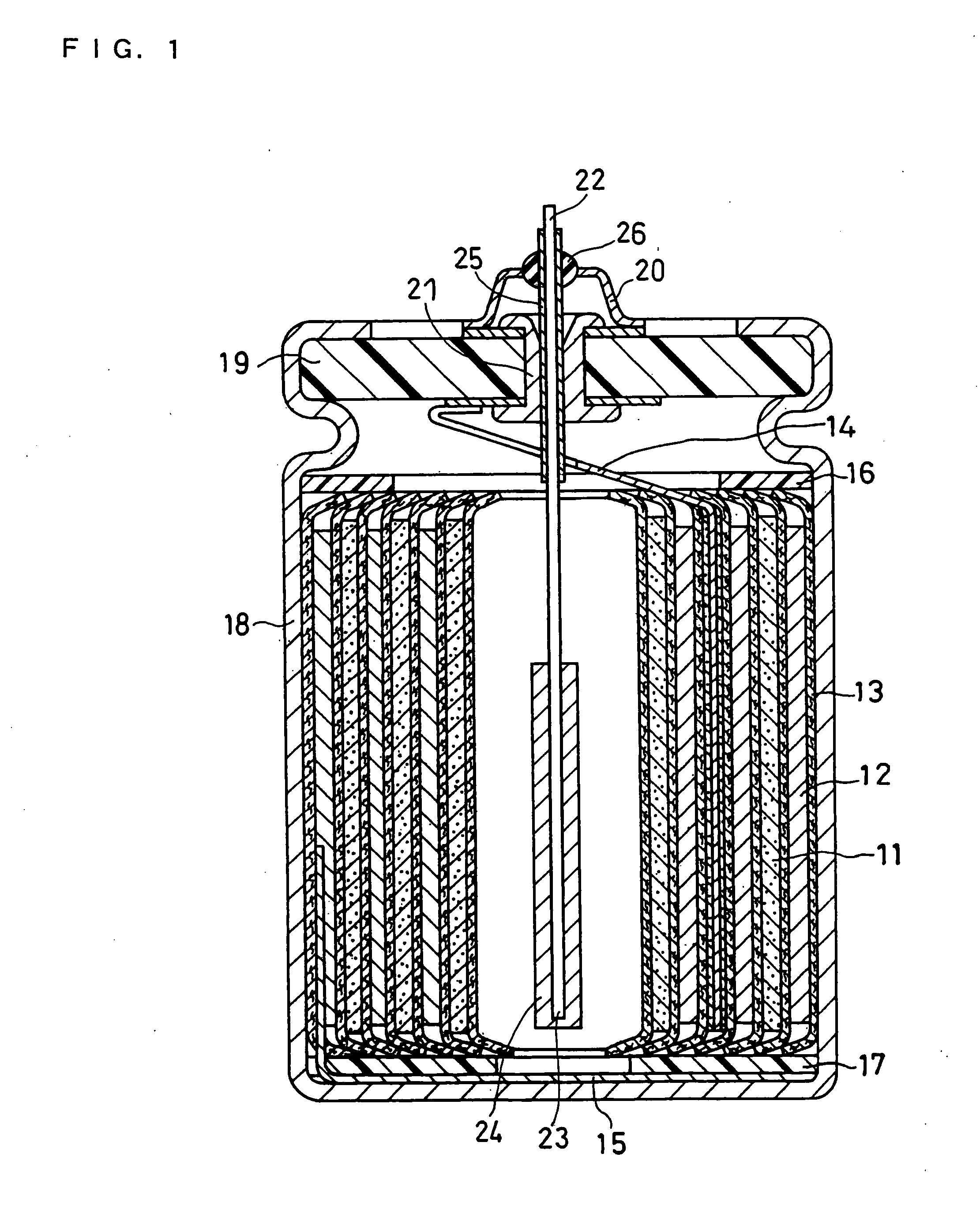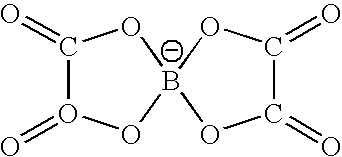Non-aqueous electrolyte secondary battery
a secondary battery and non-aqueous electrolyte technology, applied in the direction of electrolytes, electrochemical generators, cell components, etc., can solve the problems of battery malfunction, high risk of deterioration, and inability to achieve dramatic capacity increase, etc., and achieve high capacity
- Summary
- Abstract
- Description
- Claims
- Application Information
AI Technical Summary
Benefits of technology
Problems solved by technology
Method used
Image
Examples
example 1
[0056] In this example, negative electrodes and cylindrical batteries were produced in the following manner and evaluated for the cycle life and discharge capacity.
(1) Production of Negative Electrode
Negative Electrode (i)
[0057] A graphite crucible with Si metal (purity 99.999%, Furuuchi Chemical Corporation, ingot) placed therein and an electron gun were set in a vapor deposition device. An electrolytic copper foil (thickness 20 μm, available from Furukawa Circuit Foil Co., Ltd.) serving as a current collector sheet was introduced into this vapor deposition device at a constant speed (5 cm / min) from a roll, to deposit Si onto the surface of the copper foil. The deposition conditions were set at an acceleration voltage of −8 kV and a current of 150 mA. The degree of vacuum in the device was set at 3×10−5 Torr in performing the following vapor depositions unless otherwise specified.
[0058] After the deposition of one side of the current collector sheet was completed, vapor depos...
example 2
[0095] In this example, the acid content of the non-aqueous electrolyte was examined. Using the negative electrode of the battery 9, cylindrical lithium ion secondary batteries were produced in the same manner as in Example 1. Specifically, batteries 20 to 25 were produced by varying the drying condition of the negative electrode (ii) (vacuum drying at 190° C. for 12 hours) as shown in Table 2. Table 2 shows the detected acid contents of the electrolytes and battery characteristics.
TABLE 2NegativeelectrodepotentialCapacityAcidduringretentioncontent ofDischargestorageRecoveryrate afterNegativeDryingelectrolytecapacity(V vsrate100 cycleselectrodecondition(ppm)(mAh)Li / Li+)(%)(%)Battery 20NegativeStored at 20° C.23118200.854231electrodein a dry(ii)atmosphere witha dew point of−60° C. or lessfor 24 hoursBattery 21NegativeDried at 60° C.18918800.897066electrodewith hot air(ii)for 10 hoursBattery 22NegativeDried at 190° C.14518900.887578electrodewith hot air(ii)for 10 hoursBattery 23Nega...
example 3
[0099] In this example, the effect of impurities contained in the negative electrode was examined. The negative electrode active material used in this example was prepared in the same manner as in the negative electrode (ii), except that the balls used in mechanical alloying were made of S45C steel (Fe-0.45% C steel) instead of stainless steel and that the operation time was increased to 80 hours, 100 hours, or 150 hours. The resultant alloys had a wide particle size distribution of 0.5 μm to 80 μm. By classifying them with a sieve (10 μm under), alloy materials with a maximum particle size of 8 μm and a mean particle size of 5 μm were obtained. These alloy powders thus obtained were named alloy “b”, alloy “c”, and alloy “d”.
[0100] These alloys “b” to “d” were subjected to an ICP spectrometry to examine impurities, and it was found that the transition metal elements other than Fe were below the detection limit. The amount of Fe was 680 ppm in the alloy “b”, 980 ppm in the alloy “c”...
PUM
| Property | Measurement | Unit |
|---|---|---|
| end-of-discharge voltage | aaaaa | aaaaa |
| end-of-discharge voltage | aaaaa | aaaaa |
| voltage | aaaaa | aaaaa |
Abstract
Description
Claims
Application Information
 Login to View More
Login to View More - R&D
- Intellectual Property
- Life Sciences
- Materials
- Tech Scout
- Unparalleled Data Quality
- Higher Quality Content
- 60% Fewer Hallucinations
Browse by: Latest US Patents, China's latest patents, Technical Efficacy Thesaurus, Application Domain, Technology Topic, Popular Technical Reports.
© 2025 PatSnap. All rights reserved.Legal|Privacy policy|Modern Slavery Act Transparency Statement|Sitemap|About US| Contact US: help@patsnap.com



